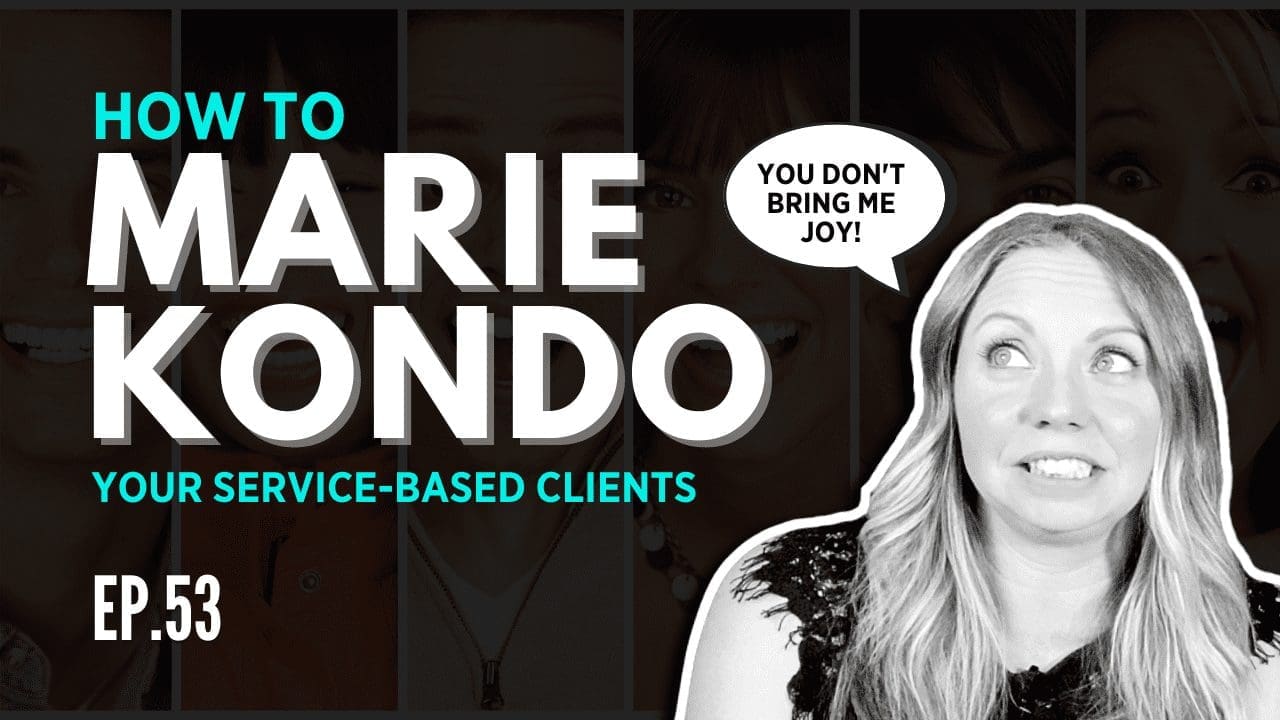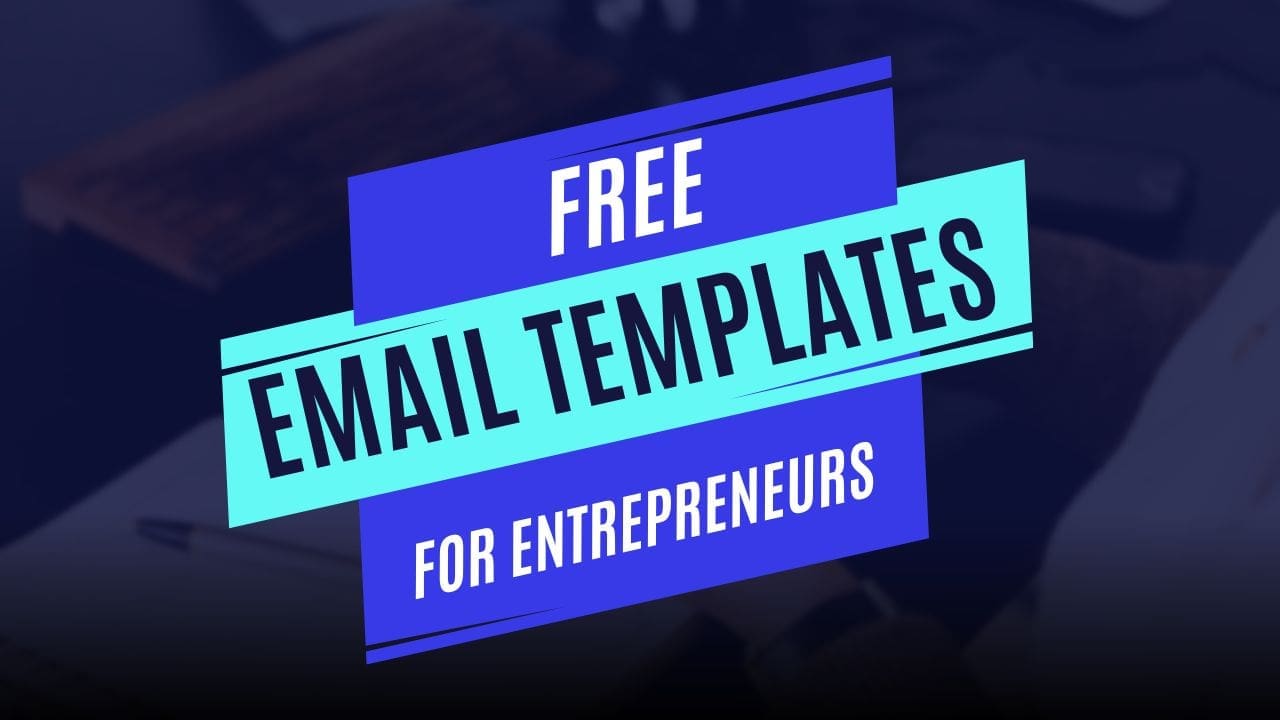Ep. 53 When Clients No Longer Bring You Joy – How to Fire Your Clients

When Clients No Longer Bring You Joy – How to Fire Your Clients
If you’re a service-based business owner, you have to choose your clients wisely. Since you only have so much time, you have to be sure each client meshes with both your personality and values.
Torie Mathis and her co-host Sean talk about why every service-based business owner must Marie Condo their clients.
We go over the exact steps to qualify, review, and fire your clients.
Recommended Tools:
Kartra https://toriemathis.com/kartra
Constant Contact https://toriemathis.com/constantcontact
WP-Engine https://toriemathis.com/wpengine
Grammarly https://toriemathis.com/grammarly
Get SMART AF resources and tools to grow your business at besmartaf.com
Listen or watch the full episode below:
EPISODE TRANSCRIPTION –
(transcription is auto-generated)
SAF 53
[00:00:00] Torie: So you’re going to Marie Kondo your client’s Sean’s. Yes. If they don’t bring me joy, don’t want to work with them anymore.
Hey. Hey, welcome to Smart AF I’m your host Torie Mathis. We got a great show for you today, so let’s get started. Hey guys. Welcome to the show I’m Torie Mathis here with my buddy, my pal, Sean Mathis.
[00:00:28] Sean: Hello.
[00:00:30] Torie: So we were talking the other day about how service based businesses. It’s super important that you get clients that you really want to work with. We have had a couple of nightmare clients. Luckily we haven’t had too many. And let me tell you, the whole vibe of working is so much different when you have clients that, that just like they’re a match for your business and your personality.
[00:01:03] Sean: Yeah. When you have clients that like you talk about having hate, hate saying, oh, it’s Monday and all that kind of crap, right. That cliche, just, you don’t want to go to work kind of thing as a business owner, you know, it shouldn’t be like that ever, but every once in a while, a client can sneak in and start to make things feel like that. We’re like, you don’t want to go and you don’t want to open your email and you don’t want to deal with anything that this client is doing because you know, they’re either, maybe they’re not straight up a jerk, but they, they just pain in the ass for one reason or another. They don’t realize.
[00:01:46] Torie: I think there’s different personality types. And I think that there’s people that are very like mothery or whatever. And so they, they need those like really needy class. So those people mesh well, you know, so I think that it’s a pain in the ass for you might not be a pain in the ass for somebody else.
There’s, you know, a pain in the ass out there that will work clients.
[00:02:07] Sean: You know, if, if you’re the type of person that wants to. Call for every little thing. Send me an email to call. And, you know, and we’re really, it could have just been in an email. Like we’re probably not the best, right?
[00:02:23] Torie: If you, yeah. So, we deal with a lot of our clients through email or through text, because a lot of the things that we’re doing, they’re like little quick things or things that can be. You don’t need a phone call for a lot of the things that we do. Plus it, it takes so much longer to get things done. Some things like updates to a website. Like if you can type those out and we can copy and paste names or whatever like it’s so much easier. Like those types of things need to be an email. And so, yeah, I agree. Like we work best with people that are cool with working through email.
[00:02:53] Sean: I’ve gotten calls or like I got updates to the. And like, they’re expecting me to stay on the phone with them the entire time as we go through and up. Like, I don’t have time for.
[00:03:03] Torie: Well, and that’s a hard way to get everything right? Like you know, we talk about not knowing what goes is involved in some of these things. Like it’s not something that you can always just, you know, go in there and change it really quick. It can be very involved that you don’t really have the time to sit there to make all those little changes. Plus we’re making changes to a live website. So it’s best that those things are done when it’s appropriate to do those things. But so what do you do when you have a phone with you? You have clients that want to call you all the time.
[00:03:33] Sean: Luckily, it doesn’t happen too often. I’m naturally a nice guy though. So I deal with it for the most part. I do encourage them. Like if it’s changing all, I’ll encourage them to email me because ultimately. I’m like 98% not going to get the change done right there on the phone. Unless it’s like one simple thing that they literally could have just sent me a quick email to get it done, but if it’s like a list of them like in multiple pages, like, I don’t, I’m not going to have time for that. Unless it’s a scheduled phone call in which case we could have done. Even then I’m still gonna try, to redirect them.
[00:04:09] Torie: Yeah, I think part of it is when you if you’re a service-based business, you kind of have to train your clients to know that that’s how you want to work, but if you bitch about it and don’t tell them, that’s how you, I mean, that is how you’re going to make your yourself miserable.
[00:04:22] Sean: Well, that’s like you know, since I’ve been working with you, I will and we’ll get a new design. I, you know, I’ve learned like you get two sets of changes. If it’s design something, I’ll tell them. Right. So just so that they know maybe they do get three because you know, one was, you know, super simple or whatever the case may be or typo kind of stuff. So it’s not like black and white note, you’ve got two changes, you know, you got. But at least there’s the expectation that you know, cause some of them, they think we’ll, we’re going to get through, we’re going to go back and forth, you know, a hundred times until we get it right. It’s like, no, we’re not.
[00:05:00] Torie: Well, I think if you let them do that like they’ll change the whole design. Like you have to make decisions or you have to like talk to everybody you need to and figure it out. Don’t like, keep like, oh, I support.
[00:05:11] Sean: Yeah. My friend says you should use this color. No.
[00:05:15] Torie: You know, and I think, I think with that, that’s part of like, you have to train your client. And set those expectations so that, you know, you, you start to mesh well with them, but you know what, sometimes you’re going to have people that you don’t mesh well with and you can fire them. You can fire your clients. Now, obviously, if you have like a, a business where you have customers coming in, like, you know, your home Depot or your restaurant or your obviously, you can’t really tell people I’m not going to serve you. However, if you’re a service-based business where you work one-on-one with people and you only have so much time, you kind of have to be selective about those you work with.
So there are ways to fire clients, you know, if you set the expectations and it’s still not working out, it’s okay to, you know, do some of the. One thing that you can do is you can raise your prices. That’s an easy way that you might either you’ll make it worth the pain in the butt, or the person will leave.
And we’ve done that before. I know that Sean has a client that I nicely handed off to you. And every time he comes back, you charge him probably five times more than anybody else, because. Very very, very difficult to work with his attitude doesn’t mesh with ours. Right.
[00:06:34] Sean: And he, and he’s not, he’s not a jerk by any means, but it, again, it really is just a personality difference that I don’t like how he makes me feel when I’m when I’m dealing with him and it, and, and, you know, I don’t ever want to feel like that when we’re doing this stuff. So. Try to make it so that it’s not a common occurrence.
[00:06:57] Torie: Yeah. Another thing there’s been somebody that has tried to work with me several times and I’ve talked to her on the phone a few times. I’ve, I’ve been in a group phone call a few times with her and I just already, like, I know that we would not mesh well. And I was telling her I’m not accepting new clients. I’m not accepting clients for that right now. You know, being that we can only have so many clients for a lot of the one-on-one type things that we do. It’s totally legitimate to not have clients right now. I know a lot of clients when they do that, they actually set up a waitlist and they make everybody go through a waitlist that way.
You stay on the waitlist. You don’t feel like, like, why am I the only one? Like nobody, nobody knows how many people go on the list. So if everybody goes on the waitlist and then you pick and choose who you want to do that’s a really easy way to kind of weed those people out. I have actually hooked up for a few of our coaching clients, coach clients that are coaches a way that they can take in like a questionnaire and see if a client will be a right fit for them.
And so that’s another way that you can weed out people from the very beginning. See what their budget is. See what kinds of things that they’ve already done. See how many employees they have, what size their businesses, how much sales, they have, their sales volume. That way you’re kind of pre-qualifying them that way. Hopefully, you get people that are more of a match for. I have one lady that I worked with a long time ago, and again, just, it started to be a little bit of a personality conflict. That again, she was just a little bit hard to deal with and, you know, some people are just like that. And the last time she called, I’m sorry, I didn’t call her back.
Like I don’t do that very often. I think that’s the only time that I’ve done that. But like, do you guys, I don’t want to work with. Like, I think it was just for serve to print something too. And I don’t want to work with.
[00:08:40] Sean: Once you get over the feeling bad about doing that and then realize like, that was kind of necessary. It’s not quite so bad anymore. Even like solicitors calling me, like, I hate, like, it’s awkward to just like hang up on somebody, but I’ve also gotten to the point to where, like, I don’t have time to sit there and listen to whatever they’re jabbering, you know, straight up, hang upon them.
[00:09:03] Torie: See, I can’t hang up on people. I haven’t been able to do that. So I just don’t answer the phone. So then I don’t have to hang up on people, but you know, even the thing with the clients, like in 15 years or whatever it is, like, I literally have like four people that I have felt this way about. So I mean, that’s hundreds of people we have worked with that have just been fantastic and I would work with them again and again.
And like four people that. I just, you know, it wasn’t, it wasn’t right. And sometimes you grow out of clients and I think that that’s okay too. You know, sometimes it’s just the direction you’re going might be different than the direction that your clients are going and that it’s okay to break up with them.
[00:09:46] Sean: Yeah. That, that one probably that’s probably the hardest one. When there isn’t anything really like that stands out. Like, I don’t want to work with this person, but they’re just that, that, that nagging feeling that, you know, maybe we’re just not right for each other anymore. You know, I just like how real relationships between two people, it can occur.
It happens in the business world, even, in corporate America where, you know, now all of a sudden your peer, you don’t get along with them. So you don’t like going to work. Your boss is an asshole. There are all kinds of things. I mean, it’s just, there may not ever be that one specific instance that you’re like, well, they did this, so now I might get miserable around them. It’s just for whatever reason it doesn’t bring you joy anymore.
[00:10:37] Torie: I was like, so you’re going to Marie Kondo your client’s Sean’s sake. Yes. If they don’t bring me joy. I don’t want to work with them anymore. And you could do that. Like, that’s the joy of being an entrepreneur and being your own business, like, don’t take on clients that you don’t want, that don’t fit with you and your business.
And so you got to figure out whatever it is. Like, whether it’s, you know, the questionnaire, things like that, or some type of interview process or trial, like whatever it is. And then if it doesn’t work out, it’s okay. You know, what else you can do is you can refer them to somebody. Like I’m a little bit busy right now. My client, you know, I have a lot, a lot of client load going on right now. So I really think you need to have the best experience possible. And I’m just not able to give that to you, but you know what so-and-so can and just refer them out.
[00:11:25] Sean: Even with all the software that’s out there for. Are kind of industry. I mean, we just had one where I actually was trying to talk her out of us doing, you know, what she wanted simply because I felt that what she needed, wasn’t really what she was asking for. And what I thought we could have provided.
[00:11:46] Torie: You remain very vague. You just explained better. She wanted us to design something super simple that she could have used Canva and just could have designed it herself. Like if it’s something really simple, do you really want to hire Torie to do some like it higher having me be involved? It’s like a big deal. Really? Like, do you really want me to be involved in something that’s, that’s kind of simple. Right. And so you can say like, you’re trying to be super vague, like, so we said like, why don’t you go to Canva?
There’s awesome templates on there. And you can just replace the stuff and fill it out yourself. When she was like, I am not a designer. Like I don’t do that. That’s not what I do. Like I don’t want to do it. Okay. Well then, you know, we’ll do it for you. And I did. Right. Well, it wasn’t just the one or two little things, because again, if you get me involved, that’s going to probably be, so I didn’t
[00:12:39] Sean: To like really utilize what is capable of doing like, it wasn’t going to make sense for her. Like it would’ve, it would’ve been, it would’ve been too expensive and it just wasn’t going to work, which is why I tried to push her over to Canva.
But she didn’t want to, so we wound up.
[00:12:56] Torie: Well and sometimes you don’t, sometimes you don’t even know if clients don’t know about something like that. Like to give them an option to do it themselves. They may not have known. And she didn’t know about. And she didn’t want to do it and that’s fine. Like, I think that’s cool. And so I did it. And like you said, that it ended up making the project a little bit bigger than they wanted originally because you had to have me just design one, one little teeny thing is, is kind of a lot. But I think. Right.
[00:13:21] Sean: As far as I know.
[00:13:25] Torie: Maybe it didn’t work out. We’ll find out. Can still come back to bite us. I don’t know. I think it’ll be fine. You always wanted to try to work with clients and to do what’s gonna work best for them. And I always want to do the best job possible. And offer them different solutions because sometimes they don’t know it.
Wasn’t a personality issue. We like you if you listen, if you watch this, it wasn’t that I didn’t want to. It’s just that it may not have been the right project. Marie Kondo those clients. No, you don’t have to work with people that, that aren’t a fit for you. If you’re in a service-based business, you can be a little bit choosey.
And I think you should because you know, working one-on-one with them. It’s, it takes a toll on you on your, your whole entire week. If you have those clients that just drive you crazy.
[00:14:16] Sean: We’ve even had some that we started to grow apart, right? But they paid so much, it made it that much more difficult to let them go. Ultimately, you know, they did go away and we more than recovered from it. So even from a financial standpoint, if you’re scared of, I let him go.
[00:14:33] Torie: Yeah, there is that fear, especially when they are a big client that you don’t want to let them go. But you know, you have to, you have to make room for new stuff to come in because you can only have so much in, in your bucket.
So you want new, new stuff to come in your bucket. Sometimes you got to empty, empty that other stuff out. Now come through.
[00:14:53] Sean: If it doesn’t bring you joy, get rid of it.
[00:14:56] Torie: Condo everything. So if you liked this episode, be sure to subscribe to our channel and like this video. We’d appreciate it. And we’ll see you on the next one.
[00:15:06] Sean: Right?
[00:15:10] Torie: You want to get smart tools to build your business, go to getsmartaf.com.
About Digital Marketing Expert Torie Mathis
 Torie Mathis helps entrepreneurs, like you, use digital marketing to grow your business without wasting time, money, or your sanity. She is a best-selling author, Army veteran, speaker + trainer, and your digital marketing coach. You don't need crazy tech skills, buckets of cash, or dedicated staff to market your business. In fact, you don't even need a lot of time. What you need is to be SMART.
Torie Mathis helps entrepreneurs, like you, use digital marketing to grow your business without wasting time, money, or your sanity. She is a best-selling author, Army veteran, speaker + trainer, and your digital marketing coach. You don't need crazy tech skills, buckets of cash, or dedicated staff to market your business. In fact, you don't even need a lot of time. What you need is to be SMART.
Torie hosts SMART AF, a show for non-techy entrepreneurs looking to grow their business, with her husband Sean and is the creator of SMART AF Magazine. Learn from Torie at the Smart Arsenal and on her channel.
YOU MAY ALSO LIKE
Hi! I'm Torie!
 I help entrepreneurs (like you) use digital marketing to get more clients + to make more money. And I make it easy!
I help entrepreneurs (like you) use digital marketing to get more clients + to make more money. And I make it easy!
You don’t need crazy tech skills, buckets of cash, or dedicated staff to market your business. You don’t even need a lot of time.
What you need is to be SMART.
GET SMART AF
DELIVERED TO YOUR INBOX
from your Digital Marketing Coach Torie Mathis!
Let's get SMART!
Let's Connect!







 I help entrepreneurs learn digital marketing.
I help entrepreneurs learn digital marketing.

